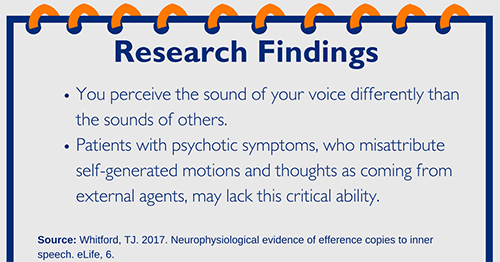As you read this sentence you probably hear the words articulated in your mind. You likely hear that same voice as you decide what to order at Chipotle or silently play out a future social interaction. This phenomenon is known as inner speech and it is estimated that we spend about a quarter of our lives doing it.1 But how different is inner speech than speaking out loud (otherwise known as “overt speech”)? Researchers at University of New South Wales (UNSW) in Sydney, Australia, have conducted a study that shows both inner and overt speech employ a mechanism that helps us recognize it as self-generated.2
Overt Speech and Sensory Attenuation
It turns out that physically identical sensations are perceived differently based on whether they’re self-generated or externally generated. This makes sense – you don’t want to be constantly aware of your arms brushing against the side of your body as you walk down the street, but you do want to be aware of the light touch of a thief reaching to steal your purse or wallet. The attenuation of self-generated sensation happens with speech as well. Listening to recorded speech activates your brain more than just hearing yourself speak out loud.3 Sensory attenuation works by suppressing predicted sensations based on our own motor output. As your brain sends a motor signal to your mouth and vocal cords to make sound, it also sends a copy that predicts what you’re about to hear, called an “efference copy.” The prediction is compared to the actual sound you hear, and if it matches, the sound you perceive is attenuated (i.e., your brain interprets it as softer).4 But this suppression only occurs if the predictions match. If you hear something the efference copy did not predict – say your voice was put through a pitch modifier or was delayed before you heard it – the suppression doesn’t happen. Thus the attenuation is said to be “time-locked and content-specific.”5

Does Sensory Attenuation Occur with Inner Speech?
If inner speech generates an efference copy to predict sensory outcomes such as overt speech, then suppression of external sounds should occur if the sound is presented at the same time as and matches the content of the inner speech. In the UNSW study, 42 participants were instructed to produce a single syllable of inner speech while an audible syllable was played. Researchers measured a component of the auditory evoked potential that has been directly linked to perceived volume of the sound. Inner speech that matched the played external sound resulted in suppression of this signal compared to the control group.2 This suggests that inner speech is similar to overt speech in that it generates efference copies that predict self-generated sensations and attenuates them.
A New Tool to Study Schizophrenia
But why would we be sending this efference copy to predict sensory feedback in a situation where there will be none, such as inner speech? One possibility is that it helps us recognize our inner speech as self-generated. This study suggests that the same mechanism that allows us to suppress self-generated overt speech as a part of sensory attenuation also allows us to recognize our inner voice as self-produced. Patients with psychotic symptoms often misattribute self-produced motor actions and thoughts to external agents.6 The tools developed within this study will allow investigators to examine deficits in inner speech attenuation in patients with psychotic disorders, such as schizophrenia.
References
- Heavey CL, Hurlburt RT. 2008. The phenomena of inner experience. Consciousness and Cognition. 17:798–810. DOI: https://doi.org/10.1016/j.concog.2007.12.006, PMID: 18258456
- Whitford, TJ. 2017. Neurophysiological evidence of efference copies to inner speech. eLife, 6.
- Curio G, Neuloh G, Numminen J, Jousma¨ ki V, Hari R. 2000. Speaking modifies voice-evoked activity in the human auditory cortex. Human Brain Mapping 9:183–191. DOI: https://doi.org/10.1002/(SICI) 1097-0193 (200004)9:4<183::AID-HBM1>3.0.CO;2-Z, PMID: 10770228
- Wolpert DM, Miall RC. 1996. Forward Models for Physiological Motor Control. Neural Networks: The Official Journal of the International Neural Network Society 9:1265–1279 . DOI: https://doi.org/10.1016/S0893-6080 (96)00035-4, PMID: 12662535
- Wolpert DM, Ghahramani Z, Jordan MI. 1995. An internal model for sensorimotor integration. Science 269: 1880–1882. DOI: https://doi.org/10.1126/science.7569931, PMID: 7569931
- Feinberg I. 1978. Efference copy and corollary discharge: implications for thinking and its disorders. Schizophrenia Bulletin 4:636–640. DOI: https://doi.org/10.1093/schbul/ 4.4.636, PMID: 734369
